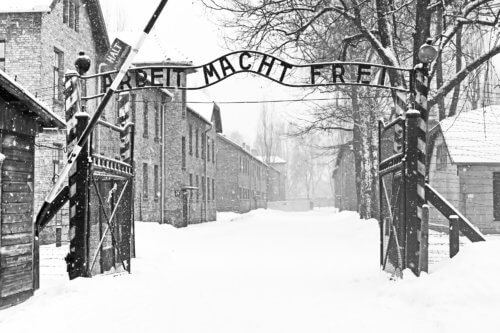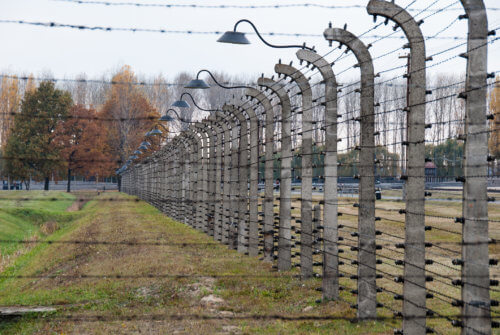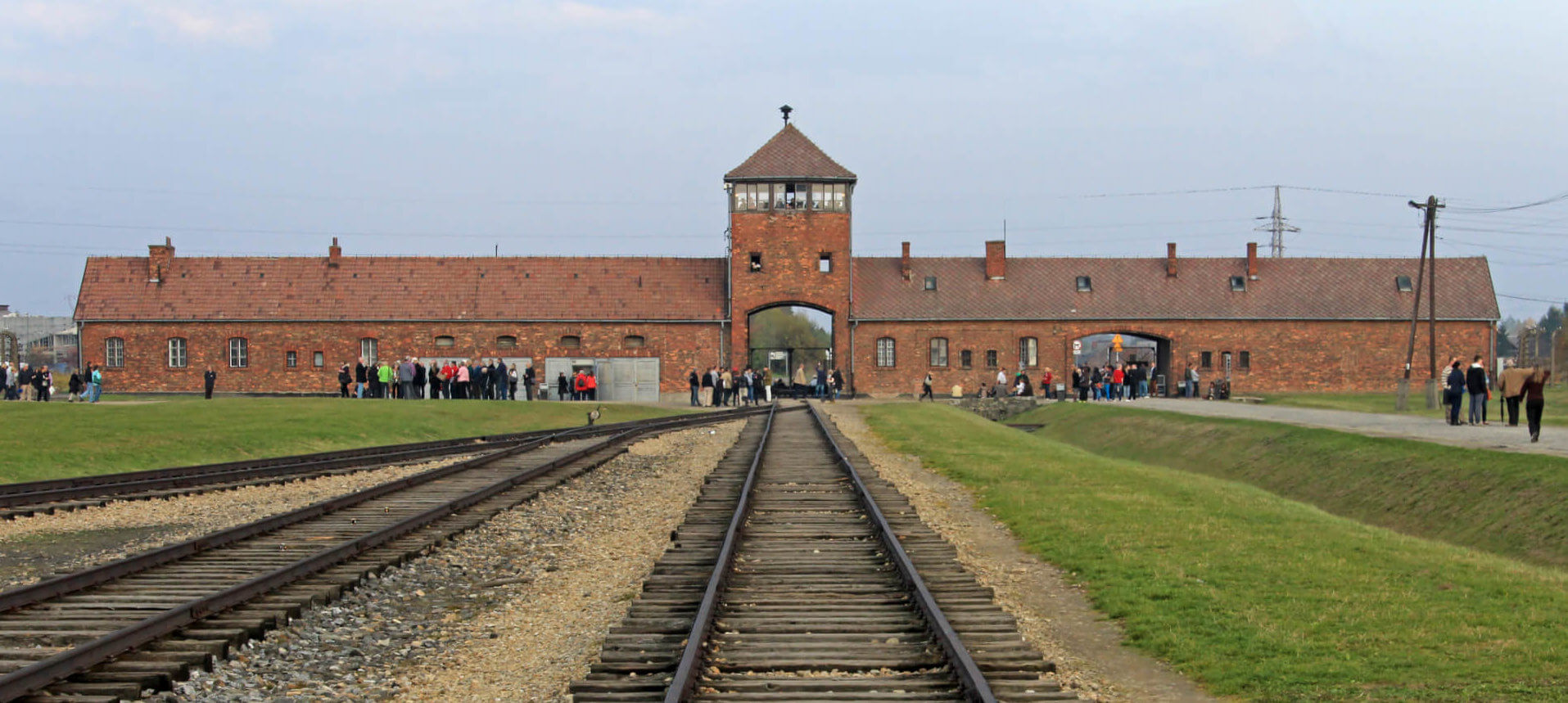January 27 marks the 75th anniversary of the liberation of the Nazi concentration camp, Auschwitz-Birkenau. On this day in 1945, Red Army troops from the 322nd Rifle Division entered the camp on horses. The Germans had left the camps before the arrival of Soviet troops and ordered the forced march of 60,000 Jews and other political prisoners to death camps located farther west. As an Allied victory became inevitable in the late fall of 1944, SS leader Heinrich Himmler ordered the gas chambers and crematoria destroyed. But, the scale of the operations was too much to dismantle. As they entered Auschwitz, the Soviets found hundreds of thousands of men’s and women’s suits, thousands pairs of shoes, and tons of human hair, much of it contaminated by the main chemical of the poison gas Zyklon B. The Nazis also left behind some 7,000 survivors who were too weak to move, along with over 600 corpses.
Soviet Lt. Ivan Martynushkin noted of the survivors: “It was hard to watch them. I remember their faces, especially their eyes which betrayed their ordeal…. We saw emaciated, tortured, impoverished people. Those were the people I first encountered…. We could tell from their eyes that they were happy to be saved from this hell. Happy that now they weren’t threatened by death in a crematorium. Happy to be freed. And we had the feeling of doing a good deed—liberating these people from this hell.
One account by a Jewish survivor stands in contrast. The Italian Jewish author and survivor Primo Levi wrote of the first Soviet soldiers: “They did not greet us, nor did they smile; they seemed oppressed not only by compassion but by a confused restraint, which sealed their lips and bound their eyes to the funereal scene. It was that shame we knew so well, the shame that drowned us after the selections, and every time we had to watch, or submit to, some outrage: the shame the Germans did not know, that the just man experiences at another man’s crime; the feeling of guilt that such a crime should exist, that it should have been introduced irrevocably into the world of things that exist, and that his will for good should have proved too weak or null, and should not have availed in defense.”

From 1941 to 1945, over 1.1 million people were murdered at Auschwitz and its complex of camps and extermination chambers. The vast majority of victims were Jews; other victims included homosexuals, gypsies, and political prisoners. Very little was published about the Holocaust after the liberation of Auschwitz. It wasn’t until after Allies liberated other camps in the spring of 1945 that the full scale of the “Final Solution” became evident. When thinking about what might have been done before the end of WWII to stop the Holocaust, it is evident that allied leaders knew much more and could have done far more than they did to slow down and impede mass murder.
Today, we still could do more to raise attention to this terrible event. In a recent Washington Post article, the education columnist Valerie Strauss noted that, in a survey of millennials, two-thirds could not identify Auschwitz, and 22 percent said they had not heard of the Holocaust or “aren’t sure what they know about it.” As a history teacher, I find this shocking. How is it possible that our nation could let our young people not understand one of the most tragic and senseless events in world history?
At Colorado Academy, we dive into this issue in Grade 6 and address it again in Ninth Grade world history. The Sixth Grade Social Studies curriculum is centered around the study of cultures and the interactions between them. Our second unit is the study of Europe, WWII, and the Holocaust. As for the Holocaust, the students learn how Hitler rose to power and the steps he took to gradually segregate, isolate, and impoverish the Jews prior to implementing the Final Solution.
Therefore, a main takeaway for the students is understanding that atrocities can occur when people do not unite and take a stand against discrimination. As such, the theme of indifference is highlighted and students are challenged to make connections to how they can be better stewards of kindness on a daily basis. The students read Donna Jo Napoli’s book, Stones in Water, and are exposed to a wide variety of other sources, including the U.S. Holocaust Memorial Museum.
In our Ninth Grade Global Perspectives class, the theme of human rights runs through the course. Students read thinkers such as Locke and Rousseau. They examine how WWII and the Holocaust led to the United Nations Declaration of Human Rights. Students read news articles, listen to relevant podcasts, and write on these issues.
The United Nations has declared January 27 as Holocaust Remembrance Day. If you have never had a conversation with your child about this terrible period in global history, I implore you to have the discussion. Obviously, it is such a horrifying subject that it is probably best reserved for students in upper elementary and beyond. A Google search can quickly give you easy access to a variety of educational sources that can be read or viewed together. I easily found this video of an oral history interview from the WWII Museum of Charlotte Weiss, a Czech Jew who survived Auschwitz and Dachau as a girl. It’s fascinating to hear her story of survival and terrible loss.

If you are interested in books, there are many to choose from. A recent study that is excellent is Timothy Snyder’s Black Earth. It is a book that goes beyond more narrow explanations of German anti-Semitism and looks more broadly at the role non-Germans played in the Final Solution. He looks at how both the Germans and the Soviets created vast areas of “statelessness” and lawlessness in Eastern Europe that allowed Jews to be systematically murdered. Another excellent study is Peter Hayes’s Why? Explaining the Holocaust. This book examines not only how the Holocaust was carried out, but also helps readers understand why it happened. For mature audiences, Elie Wiesel’s Night, Anne Frank’s The Diary of A Young Girl, and Victor Frankl’s Man’s Search for Meaning (the first part) are also classics.
There are number of films such as Schindler’s List, but there are also thoughtful films like the 2015 Hungarian film Son of Saul, which describes the experience of a Jewish prisoner at Auschwitz who worked in the camp as Sonderkommando, part of a group of prisoners who were forced to assist the Nazis killing their fellow Jews. I would also encourage you to watch the Kenneth Branagh film Conspiracy which looks at how top German officials planned the Holocaust at the Wannsee Conference in 1942. The film expertly captures how the Nazis attempted to create a legal framework to hide their evil actions.
In Valerie Strauss’s article that discusses the importance of talking to young people about the Holocaust, she includes writing from Margaret McMullan, an accomplished author who has written extensively about the Holocaust for young audiences. I encourage you to read how she approaches this with students Grades 5-12. She asks, “How young is too young to introduce students to historical evil? I don’t know, but I do know that talking with students about the Holocaust is essential. Anti-Semitic crimes, on the rise globally, doubled in the United States last year, according to the Anti-Defamation League.” The article describes McMullan’s conversations with students across the globe on this important subject. She notes, “I’ve also learned that memory is something you DO. When you remember, you recall; you tell a story. Storytellers are witnesses, but we’re also custodians of memory. And we must keep telling our stories to remember.”
